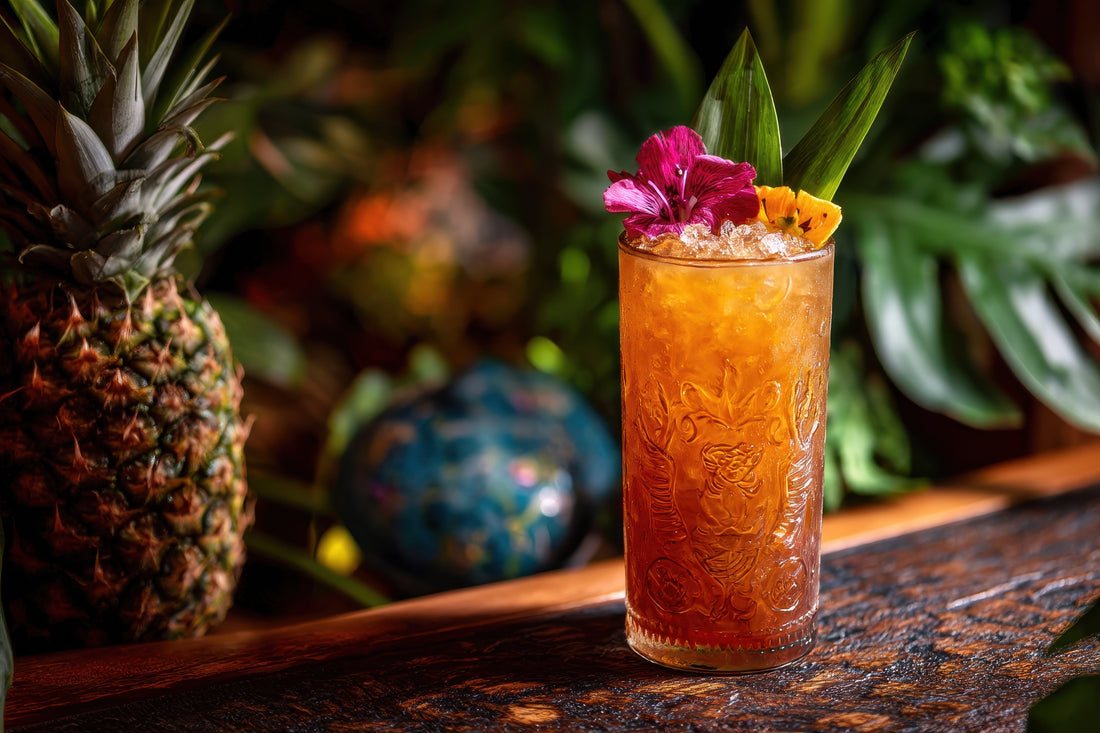
The Mysterious Rise, Fall, and Revival of Tiki Culture: Timeline
The Mysterious Rise, Fall, and Revival of Tiki Culture: Timeline
Grab your cocktail shaker, dust off your Hawaiian shirt, and light up that tiki torch—it's time to explore the fascinating (and mysterious) history of tiki culture. This tale has everything: intrigue, escapism, and a generous splash of rum. Let’s dive into the jungle, shall we?
As you read through this adventure, you’ll notice the photos scattered throughout the post showcasing some truly unique tiki mugs. These come straight from our collection of tiki glassware, a reflection of our enthusiasm for blending tiki culture’s rich history with playful, modern designs. Whether you’re hosting a luau or simply upgrading your home bar, these one-of-a-kind mugs are available for purchase—check them out and find the perfect piece to transport your cocktail hour to paradise.
The Origins of Tiki: Polynesian Mystique
The word "tiki" originates from Polynesian mythology. According to legend, Tiki was the first human created by the gods, a figure of reverence and mystery who symbolizes connection with the divine. Early tiki carvings depicted gods and spirits, standing as protectors and storytellers of Polynesian culture.
While ancient Polynesians were carving tikis from stone and wood, the rest of the world was, well… not nearly as cool. Their artwork and architecture celebrated the lush landscapes and vibrant spirituality of the Pacific islands. Fast forward a few centuries, and these exotic ideas would captivate the Western imagination—but not without a bit of creative rebranding.
1930s: The Birth of Tiki Bars
Enter Don the Beachcomber (aka Ernest Raymond Beaumont Gantt), a man who was part mixologist, part adventurer, and part hustler. In 1933, Don opened the world’s first tiki bar in Hollywood, California, cleverly named "Don the Beachcomber." Don combined his love of rum, tropical decor, and exotic vibes to create a one-of-a-kind escape from the everyday. His drinks, like the Zombie (so strong it was limited to two per customer), became instant legends.
Not long after, Trader Vic (Victor Bergeron) jumped into the game in Oakland, California, in 1934. Vic introduced the Mai Tai, arguably the most famous tiki drink of all time. The rivalry between Don and Vic added a healthy dose of drama to the tiki scene, proving that even in paradise, competition is fierce.
Fun Fact: Don’s secret recipe books were written in code, so no bartender could steal his tiki magic. If that’s not the tiki version of a spy novel, what is?
1940s–1950s: The Golden Age of Tiki
After World War II, tiki culture exploded in popularity. Returning soldiers brought stories of the Pacific islands, sparking a fascination with all things tropical. Americans were looking for escapism, and tiki bars became their paradise.
Hollywood jumped on the bandwagon, too. Films romanticized Polynesian settings, while bars and restaurants like Trader Vic’s, Don the Beachcomber, and The Tonga Room transformed the U.S. into a faux tropical utopia.
Tiki wasn’t just about drinks—it was a full sensory experience. Lava lamps, bamboo furniture, carved idols, and hula music set the mood. The tiki scene became synonymous with parties, leisure, and that ever-elusive dream of escape.
Tiki Joke: Why did the coconut refuse to share its drink? It didn't want to lose its mai tai!
1960s: The Peak (and Beginning of the Fall)
The 1960s saw tiki culture reach its zenith. Tiki mugs, Polynesian-themed hotels, and backyard luaus became mainstream. Suburban America couldn’t get enough. Themed restaurants like Kon-Tiki and Tiki Ti popped up nationwide. Even Elvis got in on the action with movies like Blue Hawaii.
But like every good party, tiki culture couldn’t stay on top forever. By the late 1960s, it began losing its charm. The Vietnam War, the rise of disco, and shifting cultural values made tiki seem outdated. People began trading their Zombies for martinis and their Hawaiian shirts for bell-bottoms.
1970s–1990s: Tiki's Hibernation
For a while, tiki culture seemed destined to become a kitschy relic of the past. Bars shuttered, tiki mugs gathered dust in thrift stores, and escapism took other forms.
But tiki never really disappeared—it was just biding its time. A small but dedicated community of enthusiasts kept the torches burning. Some tiki bars, like Los Angeles’ Tiki-Ti, weathered the decades, proving that you can’t keep a good mai tai down.
2000s: The Tiki Revival
Around the early 2000s, tiki culture began making a comeback, thanks to nostalgia and a renewed appreciation for craft cocktails. Modern mixologists rediscovered the complexity of tiki drinks, with their layers of rum, fresh juices, and syrups.
Bars like Smuggler’s Cove in San Francisco and Latitude 29 in New Orleans brought tiki back to the forefront, while enthusiasts started re-creating tiki decor with an eye for authenticity. Vintage tiki mugs became prized collectibles, and suddenly, everyone wanted a slice of Polynesian paradise in their backyard.
Today: Tiki in the 21st Century
Today, tiki culture is thriving in a new era. It’s no longer just about escapism—it’s about celebrating craft, history, and community. While some criticize its roots in cultural appropriation, many modern tiki bars aim to honor Polynesian traditions rather than exploit them.
Tiki bars have become a creative playground for bartenders and artists alike, offering everything from traditional Mai Tais to new creations like the Rum Barrel or Painkiller. Whether you’re a purist or just love a good Shark Bite cocktail served in a skull-shaped mug, there’s a place for you in the tiki world.
A Toast to Tiki
So, here we are: tiki has gone from ancient Polynesia to Hollywood, from its golden age to its quiet years, and finally to its modern-day revival. Tiki culture reminds us that sometimes, we all need a little escape—whether it’s a strong drink in a quirky mug or a night spent dreaming of palm trees and warm breezes.
And remember: In the world of tiki, the best stories start with “One more round!” 🌴🍹
Cheers! 🍍#TikiCulture #TikiHistory #TropicalEscape #RumForDays #MaiTaiForever






